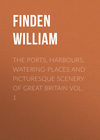Buch lesen: «The Ports, Harbours, Watering-places and Picturesque Scenery of Great Britain Vol. 1»
TYNEMOUTH LIGHTHOUSE AND PRIORY
Our present engraving is a view of Tynemouth Lighthouse and Priory, with the life-boat in the act of saving the crew of a vessel, which has struck upon the rocks at the foot of the cliff on which the lighthouse is built. This incident, so effectively and appropriately introduced by the artist, Balmer, who has frequently witnessed the scene which he has depicted, is peculiarly characteristic of the neighbourhood of Tynemouth; for, in consequence of the danger of the entrance to Shields Harbour in stormy weather, with the wind from the eastward, more vessels are there lost than at the entrance of any other harbour in Great Britain; and in no part of the kingdom has the value of the life-boat been more frequently experienced.
The view is taken from the entrance to Shields Harbour, about half a mile to the south-west of the lighthouse, which is seen rising from behind the extremity of the cliff which overlooks the entrance to Prior's Haven. Towards the centre of the land view are the ruins of Tynemouth Priory; while farther to the left, in the same distance, is seen the castle, now modernised and occupied as a garrison. The fore-ground to the left is the bank which forms the south-western boundary of Prior's Haven; and the rocks which are seen at its foot are a portion of the formidable Black Middens, which lie on the north side of the entrance to the harbour.
The principal feature of the engraving under observation is the view of the life-boat, which is introduced with a thorough knowledge of the subject, and with a feeling and a character of truth which mere imagination can never inspire. The downward plunge of a boat's bows among broken water, while her stern is at the same time elevated by a slanting wave, was never more happily represented. A person who has been at sea, may almost fancy that he hears the resounding dash of the water against the curved bow, and the seething of the angry wave as it rises on each side. The idea of motion is admirably conveyed in the representation of the wave lashing over the floating mast, which is tossed about like a light spar by the violence of the sea; and the continued inward roll of the water, from the side and bow of the boat towards the shore, is no less naturally expressed.
Part of the life-boat's crew, with most of the oars double-manned, are seen "giving way," with strenuous efforts, through the breakers, while others are endeavouring to save the shipwrecked seamen; and one of the men at the steer-oar appears to be encouraging the sailor who clings to the floating mast. The position of the boat, with her stem towards the harbour, and the shipwrecked men seated towards her stern, indicate that she is returning from the vessel, the top of whose masts are seen, and that she is now endeavouring to save such men as were washed overboard when the vessel sunk. The flying of the spray declares the loudness of the wind; and though a cheering glimpse of sunshine appears to illumine the land, yet the dark cloud, which seems to rest upon the waters to the right, sufficiently informs us of the gloominess of the prospect when looking towards the sea.
In consequence of a bar of sand, which stretches across the mouth of the Tyne, where the outward current of the river at ebb tide is met by the inward roll of the sea; and from the Herd Sand on the south, and the Black Middens on the north, the entrance to Shields Harbour is attended with great danger when the wind is blowing hard from the eastward and a heavy sea running. In crossing the bar, at such a time, a loaden ship, with rather a heavy draught of water, will sometimes strike, and unship her rudder; and a light one, in consequence of being struck by a heavy sea will sometimes broach to. A vessel thus rendered unmanageable, is almost certain, with the wind from the north-east and a flood tide, to be driven on the Herd Sand; and, should the wind be blowing strong from the south-east, she is extremely liable to be thrown either on the Black Middens or on the rocks at the foot of Tynemouth Castle; more especially in attempting to gain the harbour after the tide has begun to ebb. In the latter case, when vessels have been too late to save tide and are land-locked, and when it may seem less hazardous to attempt to pass the bar than to bring up, with evening approaching, on a lee shore, the danger of being wrecked on the rocks to the northward is more especially imminent.
LONDON: THE BRIDGES OF LONDON, SOUTHWARK, AND BLACKFRIARS, FROM THE SURREY SIDE
"O could I flow like thee, and make thy stream
My great example as it is my theme;
Though deep, yet buoyant, – gentle, yet not dull, —
Strong, without rage, – without o'erflowing, full."
Denham.
The New London Bridge, which forms so striking a feature in this View, is justly considered the finest specimen of bridge-building in Europe. It is alike the admiration of strangers and natives, and unites in the highest degree the useful and ornamental – elegance of design with solidity of structure. The first pile of this superb structure was driven on the 15th of March, 1824; and on the 27th of April, the following year, the first stone was laid by his Royal Highness the Duke of York, attended by the Lord Mayor, a distinguished party of noblemen, gentlemen, and citizens, and a great concourse of strangers, who had assembled to witness the imposing ceremony. The contracts amounted to five hundred and six thousand pounds, but the total expenditure more than trebled that sum. The clear water-way is six hundred and ninety feet out of seven hundred and eighty-two – the actual width. The carriage-way is thirty-five feet wide, and the foot-paths nine feet each. The central arch, of the five of which it consists, is one hundred and fifty-two feet in span – one of the largest ever known – it is twenty-nine feet and a half in height; and there is no weir, or fall, as in the Old London Bridge. We are thus particular in the measurements that the reader may more readily comprehend the magnificent scale upon which this great national structure has been finished; and it may be an additional facility to this purpose to state, that of granite alone one hundred and twenty thousand tons were consumed in the building.
After six years of incessant labour, it was happily brought to a successful termination under the direction of the late John Rennie, Esq., of whose genius as an architect it is a splendid monument. The opening of the bridge took place on the 1st of August, 1831, and gave occasion to a magnificent festival, which was honoured with the presence of his late Majesty William the Fourth and Queen Adelaide, the Lord Mayor, and all most remarkable for rank and station who were at that time in London. The ceremony was of the most gorgeous and gratifying description; and the water-pageant which accompanied it was the finest ever remembered on the Thames. The bridge was lined with tents and marquees, from which proudly floated the national standard, with numerous flags of societies and corporations, which gave the whole a strikingly gala-like effect. Under these a superb déjeûner, consisting of all the luxuries of the season, was served to the numerous assembly; and, to give additional novelty to the scene, Mr. C. Green, the celebrated aëronaut, ascended from the bridge in his balloon, much to the gratification of the spectators.
Immediately adjoining the Bridge, on the right, is the Steam-packet Wharf, which, from the constant landing and embarkation of passengers to and from all parts of the river, is a scene of uninterrupted stir and animation. On the left are the Bridges of Southwark and Blackfriars, with the magnificent Cathedral of St. Paul's in the centre of the picture.
The Monument (a conspicuous object on the right hand of the engraving) is a magnificent pillar, erected to commemorate the great fire of the city of London, in 1666, on the spot where it first began. It is of the fluted Doric order, and the material employed in its erection is Portland-stone of the best quality. It is one of the boldest specimens of the kind ever attempted, being two hundred and two feet in height, and fifteen in diameter, and stands on a pedestal forty feet high and twenty-one feet square; and within the shaft is a spiral staircase, consisting of three hundred and forty-five steps, formed of black marble. It was begun in 1671, but not completed till seven years after, as the great demand for stone in the restoration of London and the Cathedral of St. Paul's absorbed nearly all that the Portland quarries could furnish. Mr. Elmes, in his Life of Sir Christopher Wren, informs us that the Monument was at first used by the members of the Royal Society for astronomical experiments; but was abandoned on account of its vibrations being too great for the nicety required in their observations. This occasioned a report – extensively circulated at one time – that it was unsafe; but its sound foundation and scientific construction may bid defiance to all attacks, but those of earthquakes, for centuries to come.
This View of the Metropolis, from Southwark, is exceedingly grand and impressive, and presents a faithful picture of the every-day scenes which are here passing before the eyes of the spectator – dazzling his eye, and filling his mind with those images of unbounded wealth, power, and magnificence, of which there is no precedent in ancient or modern history.
HARWICH
Harwich is in the county of Essex, and lies on the south side of the estuary formed by the confluence of the Stour and the Orwell, about sixty-two miles to the north-eastward of London. The view in the engraving is taken from the southward, and comprises three of the most conspicuous objects in the town – the church, which is of modern erection, and the upper and the lower light-houses. In the distance, to the right, is perceived Landguard Fort, which lies on the Suffolk shore, on the opposite side of the channel.
In 1318, Harwich was incorporated by Edward II., at the request of his brother, Thomas de Brotherton, Earl of Norfolk. In 1347, the town supplied 14 ships and 183 mariners to the grand fleet of Edward III.; and in the 17th and 18th years of that king's reign, Harwich returned two members to Parliament; but the exercise of this privilege was discontinued till 1616, when it was restored by James I.
The trade of Harwich never appears to have been extensive; and its prosperity seems to have greatly depended on the Post-office packets, which formerly used to sail from the place with passengers and letters for the northern parts of Europe. The introduction of steam-packets has, however, rendered Harwich a place of no further importance as a packet-station, and for several years past the town has been in a declining state. The fishery, which formerly contributed to the prosperity of the place, has greatly diminished since the commencement of the present century. Harwich is the only harbour between Yarmouth Roads and the mouth of the Thames that is capable of affording refuge, in gales of wind from the eastward, to vessels navigating the eastern coast. During the prevalence of strong north-east winds, sometimes from 200 to 300 light colliers, and other vessels proceeding northward, are to be seen anchored in the harbour.
On the south of the town a cliff divides Orwell Haven from the bay, that extends to Walton-on-Naze. This cliff is observed to be constantly giving way to the action of the sea, which, it is expected, will at some future period force a passage to the opposite shore, and insulate Harwich and its vicinity. The cliff contains many acres of land, and its greatest height is about fifty feet. At the bottom, a bed of clay, of a bluish colour, about one foot thick, is succeeded by a bed of stone of nearly the same colour and thickness. Within the latter, shells and petrifactions, of various descriptions, have been found embedded. Above the stone are several beds of clay similar to that under the stone, rising to more than twenty feet. This clay, on exposure to the air, hardens into stone, and the streets of Harwich are paved with it. The town walls were formed of this material, as were also the castles of Orford and Framlingham.
During the fashionable season the town is visited for sea-bathing, and excellent accommodations are now provided, bathing-machines having been introduced, and the private baths rendered most convenient. They stand in a large reservoir of sea water, which is changed at every tide, and supplied with fresh water every hour, by a contrivance on the principle of a natural syphon. In some of these baths, the water is made hot for invalids, who, if they have neither strength nor courage to plunge themselves into the water, are assisted with a chair. There are also vapour baths, and machinery to throw the sea water, either hot or cold, on any part of the body.
There is a delightful walk, called "the Lawn," much frequented in fine weather as a promenade; and not far distant from it is the Beacon Cliff, on which were formerly the signal-house and telegraph, which were, some time ago, destroyed by the encroachments of the sea. This eminence commands a grand, interesting, and extensive prospect. Parties are also frequently made by the visitors for sailing or steaming up the Orwell and Stour, and making excursions on the bosom of the ocean. The scenery of the Orwell possesses peculiar interest, the banks being studded with elegant villas and pleasure grounds.
YARMOUTH
Yarmouth, in the county of Norfolk, sometimes called Great Yarmouth, to distinguish it from Yarmouth in the Isle of Wight, lies about 123 miles north-east of London, and about twenty-four to the eastward of Norwich. In the Vignette Engraving, from a beautiful painting by E. W. Cooke, the view is taken from the shore a little to the northward of the Jetty, which is seen extending into the sea. Nearly in the centre of the engraving is seen the column erected by the county of Norfolk to the memory of Nelson; and to the right are perceived several look-outs, like so many elevated scaffolds, from which, as the shore is very low, the pilots are enabled to take a wider survey when looking out for ships which may require their assistance.
The name of Yarmouth obviously alludes to the situation of the town near the mouth of the river Yare; the word Yare, according to Druery, in his Historical Notices of Great Yarmouth, is derived from the Celtic Iar, dark, supposed to have been given to this river from the dark colour of its waters. According to Sir Henry Spelman, the ground on which Yarmouth stands became firm and habitable in the year 1008, from the recession of the sea, and the accumulation of the sands. If this account be correct, it would appear that the town began to be built almost immediately afterwards; for in the Domesday-book, which was compiled between 1080 and 1086, the place is mentioned, with the usual carelessness of the Norman scribes, by the name of Cernemude; and the entry further records that the place had been held by King Edward [the Confessor], and that it "always had seventy burgesses."
In 1208, Yarmouth received a charter of incorporation from King John; and the privileges of the town were confirmed and enlarged by several succeeding kings. In 1228, in the reign of Henry III., Yarmouth had become a considerable port, both for the importation and exportation of merchandize; and in a charter of Edward I., granted in 1306, it is especially mentioned as a place where fishing-vessels, from an early period, had been accustomed to land the herrings which they caught during the season of the fishery. In 1347, Yarmouth supplied 43 ships and 1,095 mariners to the grand fleet of Edward III. and in 1349, the town was visited by a dreadful plague, which carried off seven thousand of the inhabitants. In the 31st of Edward III., an act was passed regulating the annual herring fair at Yarmouth, and appointing it to be governed by the barons of the Cinque Ports, according to the composition made between them and the inhabitants of the town in the reign of Edward I., the king's grandfather. One William Beukelem, of Biervliet, in Flanders, who died in 1397, according to Anderson, in his History of Commerce, is said to have been the inventor of the method of pickling herrings: but this cannot be correct; for though he may have introduced some improvements in the mode of cleaning and barrelling the fish, the inhabitants of Yarmouth and other places on the eastern coast were accustomed both to pickle and smoke herrings long previous to the time when the practice is said to have been introduced by Beukelem. Yarmouth is still the principal place of resort on the eastern coast of England for vessels engaged in the herring fishery, which there commences about the 21st September, and concludes about the 14th December. Most of the Yorkshire five-man boats come to Yarmouth in the herring season, and make their fishery from that place, disposing of all the herrings which they catch to curers who live in the town.
The quay at Yarmouth is one of the longest and most spacious of any in the kingdom; but from the shallowness of the entrance of the harbour, there being only fourteen feet of water on the bar at spring tides, the trade of the place is chiefly carried on in small vessels. It is high water in Yarmouth Roads at forty minutes past eight, and at Yarmouth Sands at thirty minutes past ten, on the full and change of the moon.
The column erected to the memory of Nelson stands on the low sandy flat, called the Denes, to the south of the town. Its total height, including the basement and the figure of Britannia at the top, is 144 feet, and it is ascended by a staircase consisting of 217 steps. It forms a conspicuous object when seen from the sea; and to the crews of vessels passing through Yarmouth Roads it is a proud memento of Nelson's fame and the naval glory of their country.
"O England! – dearer far than life is dear,
If I forget thy prowess, never more
Be thy ungrateful son allowed to hear
Thy green leaves rustle, or thy torrents roar!"
YARMOUTH QUAY
'Twas from the "craft of sail and oar"
That states and kingdoms sprang of yore;
When Commerce ceased to woo the wind,
Their wealth decreased – their power declin'd —
Then, thou who lov'st thy native shore,
Pray Heaven to bless "the sail and oar!"
The subject of the annexed View, representing the Quay at Yarmouth, conveys a faithful idea of that interesting and important locality. It is considered by competent judges as the finest quay in England, and in point of length exceeds every other in the United Kingdom. It is one hundred and fifty yards in breadth, contains in its centre a delightful promenade – planted on each side with trees, protected from the east wind by a row of handsome and well-built houses – and presents in all its aspects a striking combination of commercial activity and ornamental beauty. To the elegant Town Hall, which occupies the centre of this space, and to other public buildings, we have briefly alluded elsewhere. As a grand panorama of commercial life, it would be difficult to point out a finer scene than what is every day presented on the Quay at Yarmouth. Its principal foreign connexion is with the Baltic; and its trade in coal, corn, and other merchandise, coastwise, is very extensive. By means of the navigable rivers Yare, Waveny, and Bure, it possesses great facilities of intercourse with the interior of the county.
In Yarmouth Roads – so renowned for the safe riding they afford to shipping – the anchorage is extensive, and there is room for any number of ships. The Roadstead, however, is better calculated for summer than winter, for to large vessels it is only accessible in the daytime with safety.
The trade for which Yarmouth is peculiarly noted is its fisheries, which are an unfailing source of wealth and employment to the inhabitants, and have proved an invaluable nursery for those hardy and gallant seamen who have so often fought and conquered in the battles of their country. The mackarel1 fishery begins in the end of April, and ends in the beginning of July. The herring2 fishery commences at Michaelmas, and continues till the end of November; during that interval, it affords constant employment to sixteen hundred fishermen, besides six or seven hundred men and women who are engaged in the curing-houses.3 In addition to all these, many others are occupied in the various manufactures connected with the fishery – in the preparation of nets, rope, twine, baskets, coopering, &c.
The number of registered vessels belonging to the Port of Yarmouth is about six hundred, exclusive of fishing-smacks and other small craft. Ship-building is carried on to a great extent; and the artificers in the various departments of the building-yards are considered eminently skilful. There are several private bonding-warehouses, besides that on the South Denes belonging to the Custom-house. On the North Denes are the silk-mills of Messrs. Grout and Co.; and on Cobham Island are considerable salt-works for the use of the town and fisheries. At South Town, or Little Yarmouth, the banks of the Yare – besides the handsome houses by which they are lined on the south – are occupied by docks, timber-wharfs, and shipbuilding-yards, in which a large proportion of the vessels belonging to Yarmouth are constructed and fitted out for sea.











